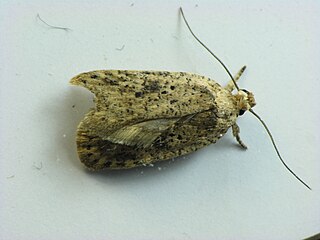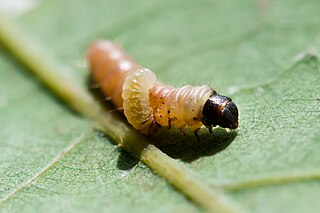
Edward Meyrick was an English schoolmaster and amateur entomologist. He was an expert on microlepidoptera and some consider him one of the founders of modern microlepidoptera systematics.

Spilomelinae is a very species-rich subfamily of the lepidopteran family Crambidae, the crambid snout moths. With 4,135 described species in 344 genera worldwide, it is the most speciose group among pyraloids.

Urodidae, whose species are commonly known as false burnet moths, is a family of moths in the lepidopteran order. It is the type genus in the superfamily, Urodoidea, with three genera, one of which, Wockia, occurs in Europe.
Metachanda is the sole genus in tribe Metachandini of moth subfamily Oecophorinae. Metachandini was originally described as family Metachandidae by Edward Meyrick in 1911, and at the time also contained the genus Chanystis, which is currently unplaced to tribe within Oecophorinae. It has also previously been described as tribe Metachandini of subfamily Gelechiinae.

Scotorythra is a genus of moths in the family Geometridae erected by Arthur Gardiner Butler in 1883. All species of this genus are endemic to Hawaii.

Phthorimaea is a genus of moths in the family Gelechiidae. Species include the potato tuber moth, Phthorimaea operculella.

Depressariidae is a family of moths. It was formerly treated as a subfamily of Gelechiidae, but is now recognised as a separate family, comprising about 2,300 species worldwide.
Phostria melanophthalma is a species of moth in the family Crambidae. It was described by Edward Meyrick in 1933. It is found in the Democratic Republic of the Congo.

Psilocorsis is a genus of moths of the family Depressariidae.
Psilocorsis argyropasta is a moth in the family Depressariidae. It was described by Walsingham in 1912. It is found in Mexico.
Psilocorsis propriella is a moth in the family Depressariidae. It was described by Zeller in 1877. It is found in Colombia.
Psilocorsis purpurascens is a moth in the family Depressariidae. It was described by Walsingham in 1912. It is found in Guatemala.
Psilocorsis exagitata is a moth in the family Depressariidae. It was described by Edward Meyrick in 1926. It is found in Colombia.
Psilocorsis amydra is a moth in the family Depressariidae. It was described by Ronald W. Hodges in 1961. It is found in North America, where it has been recorded from Arizona.
Psilocorsis arguta is a moth in the family Depressariidae. It was described by Ronald W. Hodges in 1961. It is found in North America, where it has been recorded from Arizona.
Psilocorsis cirrhoptera is a moth in the family Depressariidae. It was described by Ronald W. Hodges in 1961. It is found in North America, where it has been recorded from Arizona.
Psilocorsis fatula is a moth in the family Depressariidae. It was described by Ronald W. Hodges in 1975. It is found in North America, where it has been recorded from Texas.
Psilocorsis indalma is a moth in the family Depressariidae. It was described by Walsingham in 1912. It is found in Guatemala.
Psilocorsis minerva is a moth in the family Depressariidae. It was described by Edward Meyrick in 1928. It is found in Colombia.

Epermenia is a genus of moths in the family Epermeniidae. The genus was first described by Jacob Hübner in 1825.







